Yes, light in the UV-C part of the spectrum will destroy the virus. Here are the basics and a few myths surrounding these light emissions.
For those of us still working, it can be a bit unsettling to ponder whether the surfaces we touch harbor a few virions left over from someone infected with Covid-19. When it’s impractical to swab down everything with bleach, bathing with light in the UV-C part of the spectrum might be a useful alternative.
Light in the ultraviolet C band (100 to 280 nm wavelength) has long been used as a disinfection method in food, air,
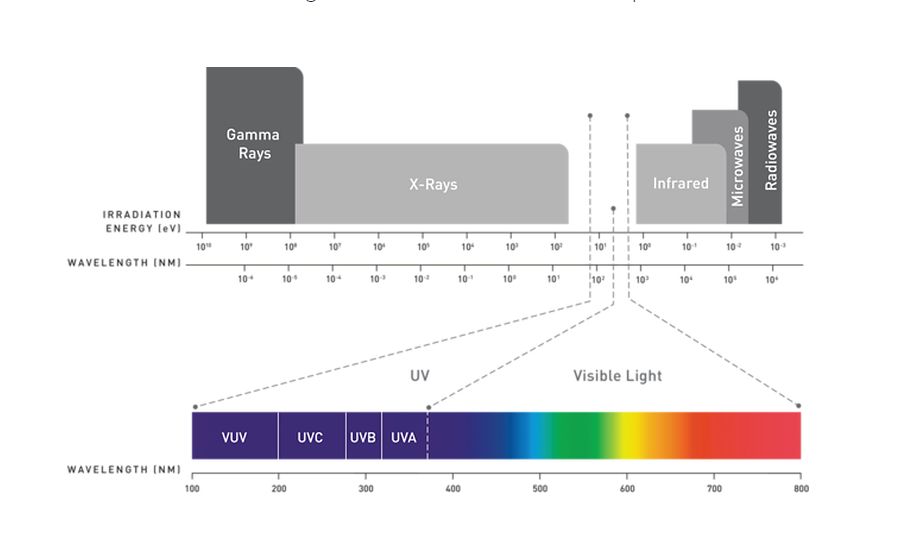
and water purification. It works by destroying nucleic acids of microorganisms and disrupting their DNA. Unfortunately, conventional germicidal UV light is also a human health hazard leading to rapid sunburn or skin cancer as well as an inflammation of the cornea and cataracts. So it isn’t used much in public spaces.
Nevertheless, UV-C lamps are readily available and can be safely used with inexpensive protective gear such as glasses.
The usual means of generating UV-C for disinfection is most typically with a mercury-vapor lamp that produces light through use of an electric arc through vaporized mercury. These low-pressure lamps have a typical efficiency of approximately 30–40%, But recent developments in technology have led to commercially available LEDs able to generate UV-C light. Like other kinds of LEDs, UV-C types last far longer than their non-solid-state counterparts. One proviso is that the electrical-to-UVC conversion efficiency of LEDs is currently lower than that of mercury lamps.
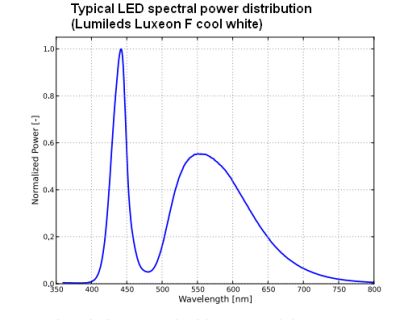
Unfortunately, there have been several myths about LEDs and UV light that still float around the internet. One is that ordinary LEDs for general-purpose illumination generate UV and even UV-C light as they age or just as a byproduct of their main illumination spectrum. Both assertions are false. They likely arise from misunderstandings about phosphor-converted white LEDs (PC-LEDs). These are created either from blue- or near-ultraviolet-emitting chips putting out light at about 450 nm that are coated with a yellow phosphor. The phosphor down-converts the light output into lower visible light frequencies. PC-LEDs that operate this way are sometimes said to be high-CCT, 450-nm blue-pump types with the “pump” denoting the down-conversion process.
The myth is that UV light leaks out from beneath the yellow phosphor on the LED die. But our own tests, as well as tests conducted by the Dept. of Energy, have found no output in the UV-C range from garden-variety LED bulbs. Moreover, LED makers generally publish graphs of spectral response for the LEDs they provide. A review of these graphs shows that most of the output for LEDs designed for general illumination is at 450 nm wavelengths and longer. The output at shorter than 400 nm is essentially nil. We looked at the published spectral response curves of general illumination LEDs made by several mainstream suppliers and we could find none that had any output at UV frequencies.
Those interested in UV-C lights have numerous choices available. A recent review of products available on Amazon.com revealed several 12-in-long UV-C lamps available for under $20.
But if you plan on disinfecting surfaces around your workbench with this kind of light, note that the fact that UV-C radiation can break down chemical bonds leads to rapid aging of plastics, insulation, gaskets, and other materials. And plastics sold as “UV-resistant” are tested only for UV-B. This is a point to note because it takes a while to disinfect surfaces with a UV-C light. In one research study, it took a 30-minute exposure to a 40-W UV-C lamp to kill what the researchers called medically important bacteria.

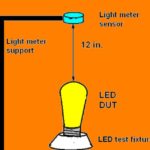
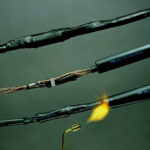

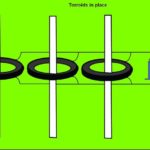

Commercially uv-c LEDs are avaliable on the market from near 10 years ago , the big problem of these led types is:
1- output power range is very limited ( common uvc leds are under 500mw range and this is not usable power on many applications with attempt to their very low efficiency ( near 10% compared compared to 30-40% of mercury wapur uv-c lamps and power ranged from 1W to hundred watts
2- price of these low power leds is very high when compared to other led types ( IR – visible light , uv-a and b spectrum leds ) . You can buy any led except uv-c in range of few ten to hundred watts for under 10 usd . An 200mw uv-c led tagged for 30 to 50usd or more from branded supplies!
This is an example of one cheap 200mw uv-c led for 25usd
https://m.alibaba.com/product/60825075601/high-power-uv-c-led-265nm.html?s=p
Thanks for an educational posting about the type and power level needed for germ killing, as well as pointing out the common confusion. The mercury vapor lights do have a real advantage in that they do not need an additional heat sink, whikle high powered LEDS certainly would need such..
This is an interesting article; but the reference to UV-C LEDs from China looks very suspicious; I own Amana AC unit which had “germicidal filter” inside which consists of one 405nm 10mW LED and a piece of paper honeycomb air filter. I am ready to assume that what is currently being sold is in fact and array of 405nm LEDs which have Zero germicidal action. There are also “LED” light fixtures advertised there which show transparent glass tubes and are in fact mercury bulb in a fancy light fixture.
Did anyone try these “LED” UV-C products and can confirm their spectrum as well as the fact that they produce ozone which can be smelled? This would be the indication that you are not dealing with the fake product whose only intent is to make money from ignorance of the buyers in these critical times?
P.S. I am not sure how to read the specs (as always on Alibaba), is the chip in the picture 0.2mW or it is 0,2W? The picture does not show multichip module, so which line of the spec applies? Is it a typo? The picture shows a window: what is the material of this window?
Item high power uv c led 265nm for sterilization system
Power 0.2W
Color UV C led
Chip Brand Epileds
Chip Size 45mil
Radiant Flux 0.2mW/chip
Wavelength 265nm
Working Current 350mA
And this is a “User Friendly Product”
https://images-na.ssl-images-amazon.com/images/I/71Bb776n3OL._AC_SL1500_.jpg
UVC is officially 200 nm to 280 nm, anything below 200 nm that is considered Vacuum UV, and it creates ozone (which is not good to breath, as it is as reactive as chlorine). 265 nm seems to be the most effective at deactivating viruses and bacteria, but 255 nm and 270 nm are also useful, depending on the pathogen you are trying to kill.
As the wavelength gets smaller, the UV LEDs put out less & less radiant flux, typically measured in mW/cm2. A 255 nm SMD LED will put out about 5 mW/cm2, a 265 nm LED will put out about 10 to 18 mW/cm2, and a 275 nm LED can put out upwards of 35 mW/cm2. The windows on the LEDs are typically fused quartz or sapphire, as glass blocks UVC.
I’ve been looking into myself, as I thought one could use an 1.5″ diameter x 2 foot long (about 1 liter of volume) polished (on the inside) aluminum tubing in which to mount some UVC LED’s into (aluminum reflects UV @ 85~90%), as to counteract the inverse square law making the emitted UVC more effective. IF the UVC LED light sources were strong enough, you could make a breathing apparatus (non disposable) that would operate off a small rechargeable battery pack. Normal tidal breathing is about 0.5 liter, so the reason for a 1 liter of volume is so that when the air stops moving for a second when the user breaths out (one way air valves people), that would give the UVC LED’s more time to disinfect the incoming air stream. The aluminum pipe would be partially bent into a 180 degree U shaped piece, with LEDs mounted on both ends facing the curve. The aluminum tube can also serve as one of the electrical conductors and as a heatsink for the LEDs. This would attach on both ends to a diffuse plastic coated/embedded with phosphorescent paint/dye (visual proof that it is operating) that would come over the shoulder and basically hook it onto the person’s shoulders. One end would have a basic filter on it (to keep dirt out), and the other end would connect to a flexible hose going to the breathing mask.
The data I’m missing is the amount of radiant flux needed (per second per cm2) to kill most viruses, which is probably given in j/s/cm2 (joules per second per square centimeter). Anyone with this info, please forward any pertinent links to me at johnsmithjunk256ATgmailDOTcom (<– replace the AT & DOT)
A-virus seems to need 222 nm UV light 2 mJ/cm2 to about the ffp3 level.
I think one would need to aim at 2 mJ/cm2, given that 222 nm is “less lethal” than 275 nm.
The study selected 222 nm as it was deemed safe for public places. One could, in theory, irradiate rooms with people.
UV light generates Ozone in the air.
Ozone (O₃) is a colorless to blue gas with a pungent odor. Exposure to ozone may cause headaches, coughing, dry throat, shortness of breath, a heavy feeling in chest, and fluid in the lungs. Higher levels of exposure can lead to more severe symptoms.
after checking things up more, I will update my latest post with the following link:
http://www.uvresources.com/blog/the-ultraviolet-germicidal-irradiation-uv-c-wavelength/
There is an open source mask page here, with links to other sites with the same ideas,
https://www.powerelectronictips.com/killing-covid-19-with-uv-c-leds/
one guy on reasearchgate says he has a patent.
I’ve written authorities stating I think there needs to be a patent pool for this technology right now, especially concerning far-uvc. Does anyone make a far uvc led? is it even possible?
Dm Derev, those cob bulbs are selling like crazy. I’ve asked several sellers if there are any test results online proving the frequency range and have had no response. Aren’t the individual UVC leds quite expensive? and there’s like 100 on there for 50 bucks. People are stating they are just blue light leds.
What about the led uvc wands that sell out everywhere as soon as they are listed, do they have any beneficial properties at all or would people be as well off waving a magic wand over their groceries?
It has been difficult to get reliable information for LED UV lights, I bought a Size:60W UVC Germicidal lamp
Watt: 60W,
Voltage: 110V-277V
Wavelength: 254nm bulb
This item appears to be an LED UV light, However it only draws 16 watts at 120 VAC, Any information that would detail the UV wave length and intensity would be helpful, As noted by other posts, the specs for the bulb from China are not available from Amazon.
Thanks
One problem with surface UVC disinfection is that spores and microbes in the air start landing on that surface immediately after it’s been disinfected. This is one aspect that people don’t seem to want to think about — spot cleaning surfaces is great, but without also treating the air, the surfaces won’t be clean for long.
Addressing both, though, can definitely help homeowners and employees/employers keep their environments more sanitary. In-duct HVAC UVC systems are great for keeping the UVC lights from being exposed to humans, while also disinfecting circulating air.
To respond to Dm Derev:
You posted this link: https://images-na.ssl-images-amazon.com/images/I/71Bb776n3OL._AC_SL1500_.jpg
I have one of these and am convinced it is fake.
I also received This from another seller of this product as “proof” that it is UV-C.
http://img.jeoshi.com:80/uploads1/20200416/22366f5a67cf18505a8bff57a4a4015f.jpg
As you can see, the test rep[ort actually shows no UV-C output.
It’s difficult to find an affordable UV-C LED lamp to sanitize objects. Most LEDs, I have seen, only claim 254nm (which will be ineffective), instead of the optimum 265nm.
See below:
Effectiveness of UV light on E.Coli
Each type using optimum wavelength for sanitizing
Medium Pressure UV Lamp 313nm 76% effective
Low Pressure UV Lamp 253.7nm 100% effective
UVC (UV-c) LED Lamp 265 / 266nm 100% effective
264nm & 268nm 90% effective
263nm & 269nm 80% effective
262.5nm & 270nm 70% effective
NONE of the UVC bulbs sold on Amazon are UVC.
https://hackaday.com/2020/04/15/buyer-beware-this-led-bulb-sold-as-germicidal-doesnt-emit-uv-c/
@ Lu Mahalo: Exactly 265nm? Did you find a resonant frequency of E.Coli?
But which wavelength would then coincide to Corona SARS-CoV-2 viruses? At least these are spherical, not such short worms like E.coli.
Lu Mahalo, this research says that 222nm would be the most effective https://www.nature.com/articles/s41598-018-21058-w and they were looking specifically at virii. It was published at the beginning of 2018, so they were, understandably, focused on H1N1.
@ Richard Still:
In this cited research the UV-C 222nm wavelength has been used because it was available from Kr-Cl excimer (or more exactly: exciplex) gas lamps (which predominantly emit at this wavelength). There is no evidence to be found in this report that this wavelength “would be the most effective” per se. The paper also states: “Thus as we (13,15) and others (16–18) reported in earlier studies for bacterial inactivation, 222-nm far-UVC light and 254-nm broad-spectrum germicidal light are also comparable in their efficiencies for aerosolized viral inactivation.”
This means there is no such “most effective” UV-C wavelength for viral inactivation – all wavelengths in the UV-C range (280-100 nm) are effective enough for the required purpose, possibly more effective at the shorter side of the spectrum, because of larger energy per photon.
There is one UVC solution I’ve seen in S Korea on many escalators and moving walkways:
https://www.youtube.com/watch?v=X6Gg3PqtKz8
but never seen in other countries. Looks like Korea was better prepared for viruses like COVID.
Those led bulbs from
China have a peak in the uva, but they do put out in the 254 range. This was measurable from just one tiny unit.
I cannot verify it is sufficient to kill virus, but it is better than nothing. And yeah, after zapping my stethoscope with the mercury vapor bulb – god uvc peak- the tubing is getting sticky… so back to alcohol wipes.
Some are doped and don’t put out as much ozone, some are downright wicked making ozone.
I used Usho T10… UVC compact light bulb ten years ago and they could not kill germs. I came back to hydrogen peroxide.
Hope far UVC works.
how far in feet I can disinfect with 12W, 20W, 60W bulbs? how many mAh for each of them? can we DIY to make the filter?
Thanks
You might check the FAQ put out by the Illumination Engineering Society. It talks about these issues.
https://www.ies.org/standards/committee-reports/ies-committee-report-cr-2-20-faqs/
Here’s what you’re looking for, a UV irradiation dosage table of 1 log reduction of the organism to kill 90% and a 2 log reduction to kill 99%.
The kill rates are listed for various bacteria, molds, protozoa, viruses and yeasts and how to compute the time needed to inactivate each organism.
Example: E. coli needs 3,000 microW/cm2 for 90% and 6,600 microWs/cm2 for 99%
So if the lamp produces 800 microW/cm2 @ 1 ft with 534 FPM air flow at 55 deg F, the UV dose = UV intensity x time in secs. So 3000/800= 3.75 sec and 6600/800= 8.25 sec
The link for my last comment is:
https://www.americanairandwater.com/uv-facts/uv-dosage.htm